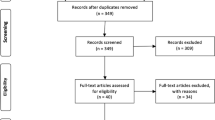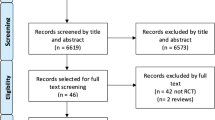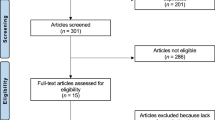Abstract
Anterior cruciate ligament (ACL) rupture is a common sporting injury, often managed surgically with patella-tendon or hamstrings-gracilis autograft. Some people who sustain the injury, request information about their prognosis if they choose to forgo surgery and opt for conservative management. Numerous studies provide data on the prognosis of conservatively managed ACL injuries. These studies have not been systematically reviewed. Thus, the aims of this systematic review are to describe the natural history and clinical course of function and proprioception in the conservatively managed ACL-deficient knee, and to identify prognostic factors. We searched MEDLINE, CINAHL, EMBASE, SportDiscus, PEDro and the Cochrane Central Register of Clinical Trials without language restrictions from the earliest record available up to July 2006. We also searched the Science Citation Index, and iteratively searched bibliographies for prospective studies of outcomes (>6 months follow-up) of conservatively managed complete ACL tears. Six criteria were used to assess the methodological quality of included studies. The main outcome measures were self-reported measures of knee function, activity level, performance in functional tasks and knee proprioception. Fifteen studies of variable methodological quality were included in the review. On average, patients with mixed or isolated ACL-deficient knees reported good knee function (87/100 Lysholm knee scale) at follow-up duration of 12–66 months. On average, functional performance assessed with the hop-for-distance test, was in the normal range. From pre-injury to follow-up there was a reduction in Tegner activity level of 21.3%. According to the methods used in the assessed studies, conservatively managed ACL-deficient knees have a good short-to mid-term prognosis in terms of self-reported knee function and functional performance. However, subjects reduced their activity levels on average by 21% following injury.






Similar content being viewed by others
References
Griffin LY, Agel J, Albohm MJ, et al. Noncontact anterior cruciate ligament injuries: risk factors and prevention strategies. J Am Acad Orthop Surg 2000; 8: 141–50
Huston LJ, Greenfield ML, Wojtys EM. Anterior cruciate ligament injuries in the female athlete: potential risk factors. Clin Orthop 2000; 372: 50–63
Irvine GB, Glasgow MM. The natural history of the meniscus in anterior cruciate insufficiency: arthroscopic analysis. J Bone Joint Surg Br 1992; 74: 403–5
McDaniel WJ Jr, Dameron TB Jr. The untreated anterior cruciate ligament rupture. Clin Orthop 1983; 172: 158–63
Shirakura K, Kobuna Y, Kizuki S, et al. Untreated acute anterior cruciate ligament tears of the knee: progression and the influence of associated injuries. Knee Surg Sports Traumatol Arthrosc 1995; 3: 62–7
Engebretsen L, Tegnander A. Short-term results of the nonoperated isolated anterior cruciate ligament tear. J Orthop Trauma 1990; 4: 406–10
Kannus P, Jarvinen M. Conservatively treated tears of the anterior cruciate ligament: long-term results. J Bone Joint Surg Am 1987; 69: 1007–12
McDaniel WJ Jr, Dameron TB Jr. Untreated ruptures of the anterior cruciate ligament: a follow-up study. J Bone Joint Surg Am 1980; 62: 696–705
Pattee GA, Fox JM, Del Pizzo W, et al. Four to ten year follow up of unreconstructed anterior cruciate ligament tears. Am J Sports Med 1989; 17: 430–5
Engstrom B, Gornitzka J, Johansson C, et al. Knee function after anterior cruciate ligament ruptures treated conservatively. Int Orthop 1993; 17: 208–13
Funk FJ Jr. Osteoarthritis of the knee following ligamentous injury. Clin Orthop 1983; 172: 154–7
Noyes FR, Matthews DS, Mooar PA, et al. The symptomatic anterior cruciate-deficient knee. Part II: the results of rehabilitation, activity modification, and counseling on functional disability. J Bone Joint Surg Am 1983; 65: 163–74
Fetto JF, Marshall JL. The natural history and diagnosis of anterior cruciate ligament insufficiency. Clin Orthop 1980; 147: 29–38
Drongowski RA, Coran AG, Wojtys EM. Predictive value of meniscal and chondral injuries in conservatively treated anterior cruciate ligament injuries. Arthroscopy 1994; 10: 97–102
Altman DG. Systematic reviews of evaluations of prognostic variables. BMJ 2001; 323: 224–8
Pengel LH, Herbert RD, Maher CG, et al. Acute low back pain: systematic review of its prognosis. BMJ 2003; 327: 323
Emerson JD, Burdick E, Hoaglin DC, et al. An empirical study of the possible relation of treatment differences to quality scores in controlled randomized clinical trials. Control Clin Trials 1990; 11: 339–52
Schulz KF, Chalmers I, Hayes RJ, et al. Empirical evidence of bias: dimensions of methodological quality associated with estimates of treatment effects in controlled trials. JAMA 1995; 273: 408–12
Delgado-Rodriguez M, Sillero Arenas M. Inclusion of research quality in meta-analyses. Gac Sanit 1995; 9: 265–72
Greenland S. Quality scores are useless and potentially misleading-reply to re: a critical look at some popular analytic methods. Am J Epidemiol 1994; 140: 300–2
Ageberg E, Zatterstrom R, Moritz U, et al. Influence of supervised and nonsupervised training on postural control after an acute anterior cruciate ligament rupture: a three-year longitudinal prospective study. J Orthop Sports Phys Ther 2001; 31: 632–44
Andersson C, Odensten M, Gillquist J. Knee function after surgical or nonsurgical treatment of acute rupture of the anterior cruciate ligament: a randomized study with a long-term follow-up period. Clin Orthop 1991; 264: 255–63
Andersson C, Odensten M, Good L, et al. Surgical or nonsurgical treatment of acute rupture of the anterior cruciate ligament: a randomized study with long-term follow-up. J Bone Joint Surg Am 1989; 71: 965–74
Buss DD, Min R, Skyhar M, et al. Nonoperative treatment of acute anterior cruciate ligament injuries in a selected group of patients. Am J Sports Med 1995; 23: 160–5
Clancy WG Jr, Ray JM, Zoltan DJ. Acute tears of the anterior cruciate ligament: surgical versus conservative treatment. J Bone Joint Surg Am 1988; 70: 1483–8
Daniel DM, Stone ML, Dobson BE, et al. Fate of the ACL-injured patient: a prospective outcome study. Am J Sports Med 1994; 22: 632–44
Friden T, Roberts D, Zatterstrom R, et al. Proprioception after an acute knee ligament injury: a longitudinal study on 16 consecutive patients. J Orthop Res 1997; 15: 637–44
Neusel E, Maibaum S, Rompe G. Five-year results of conservatively treated tears of the anterior cruciate ligament. Arch Orthop Trauma Surg 1996; 115: 332–6
Odensten M, Hamberg P, Nordin M, et al. Surgical or conservative treatment of the acutely torn anterior cruciate ligament: a randomized study with short-term follow-up observations. Clin Orthop 1985; 198: 87–93
Sandberg R, Balkfors B, Nilsson B, et al. Operative versus nonoperative treatment of recent injuries to the ligaments of the knee a prospective randomized study. J Bone Joint Surg Am 1987; 69: 1120–6
Shirakura K, Terauchi M, Kizuki S, et al. The natural history of untreated anterior cruciate tears in recreational athletes. Clin Orthop 1995; 317: 227–36
Swirtun LR, Jansson A, Renstrom P. The effects of a functional patients with old rupture of the anterior cruciate ligament. Int J Sports Med 1990; 11: 73–7
Zatterstrom R, Friden T, Lindstrand A, et al. Rehabilitation following acute anterior cruciate ligament injuries: a 12-month follow-up of a randomized clinical trial. Scand J Med Sci Sports 2000; 10: 156–63
DerSimonian R, Laird N. Meta-analysis in clinical trials. Control Clin Trials 1986; 7: 177–88
Barber SD, Noyes FR, Mangine RE, et al. Quantitative assessment of functional limitations in normal and anterior cruciate ligament-deficient knees. Clin Orthop 1990; 255: 204–14
Bengtsson J, Mollborg J, Werner S. A study for testing the sensitivity and reliability of the Lysholm knee scoring scale. Knee Surg Sports Traumatol Arthrosc 1996; 4: 27–31
Kocher MS, Steadman JR, Briggs KK, et al. Reliability, validity, and responsiveness of the Lysholm knee scale for various chondral disorders of the knee. J Bone Joint Surg Am 2004; 86-A: 1139–45
Marx RG, Jones EC, Allen AA, et al. Reliability, validity, and responsiveness of four knee outcome scales for athletic patients. J Bone Joint Surg Am 2001; 83-A: 1459–69
Demirdjian AM, Petrie SG, Guanche CA, et al. The outcomes of two knee scoring questionnaires in a normal population. Am J Sports Med 1998; 26: 46–51
Risberg MA, Holm I, Steen H, et al. Sensitivity to changes overtime for the IKDC form, the Lysholm score, and the Cincinnati knee score a prospective study of 120 ACL reconstructed patients with a 2-year follow-up. Knee Surg Sports Traumatol Arthrosc 1999; 7: 152–9
Borsa PA, Lephart SM, Irrgang JJ. Sport-specificity of knee scoring systems to assess disability in anterior cruciate ligament-deficient athletes. J Sport Rehabil 1998; 7: 44–60
Anderson AF, Federspiel CF, Snyder RB. Evaluation of knee ligament rating system. J Knee Surg 1993; 6: 67–73
Bollen S, Seedhom BB. A comparison of the Lysholm and Cincinnati knee scoring questionnaires. Am J Sports Med 1991; 19: 189–90
Tegner Y, Lysholm J. Rating systems in the evaluation of knee ligament injuries. Clin Orthop 1985; 198: 43–9
Feagin JA Jr, Curl WW. Isolated tear of the anterior cruciate ligament: 5-year follow-up study. Am J Sports Med 1976; 4: 95–100
Noyes FR, McGinniss GH, Grood ES. The variable functional disability of the anterior cruciate ligament-deficient knee. Orthop Clin North Am 1985; 16: 47–67
Fitzgerald GK, Axe MJ, Snyder-Mackler L. A decision-making scheme for returning patients to high-level activity with non-operative treatment after anterior cruciate ligament rupture. Knee Surg Sports Traumatol Arthrosc 2000; 8: 76–82
Gauffin H, Pettersson G, Tegner Y, et al. Function testing in knee brace during early treatment of patients with a nonoperated acute anterior cruciate ligament tear: a prospective randomized study. Clin J Sport Med 2005; 15: 299–304
Noyes FR, Barber SD, Mangine RE. Abnormal lower limb symmetry determined by function hop tests after anterior cruciate ligament rupture. Am J Sports Med 1991; 19: 513–8
Grob KR, Kuster MS, Higgins SA, et al. Lack of correlation between different measurements of proprioception in the knee. J Bone Joint Surg Br 2002; 84: 614–8
Roberts D, Andersson G, Friden T. Knee joint proprioception in ACL-deficient knees is related to cartilage injury, laxity and age: a retrospective study of 54 patients. Acta Orthop Scand 2004; 75: 78–83
Acknowledgements
Qassim Muaidi is supported by King Faisal University in Dammam, Saudi Arabia. Robert Herbert and Christopher Maher’s research fellowships are funded by Australia’s National Health and Medical Research Council. The authors have no conflicts of interest that are directly relevant to the content of this review.
Author information
Authors and Affiliations
Corresponding author
Rights and permissions
About this article
Cite this article
Muaidi, Q.I., Nicholson, L.L., Refshauge, K.M. et al. Prognosis of Conservatively Managed Anterior Cruciate Ligament Injury. Sports Med 37, 703–716 (2007). https://doi.org/10.2165/00007256-200737080-00004
Published:
Issue Date:
DOI: https://doi.org/10.2165/00007256-200737080-00004




